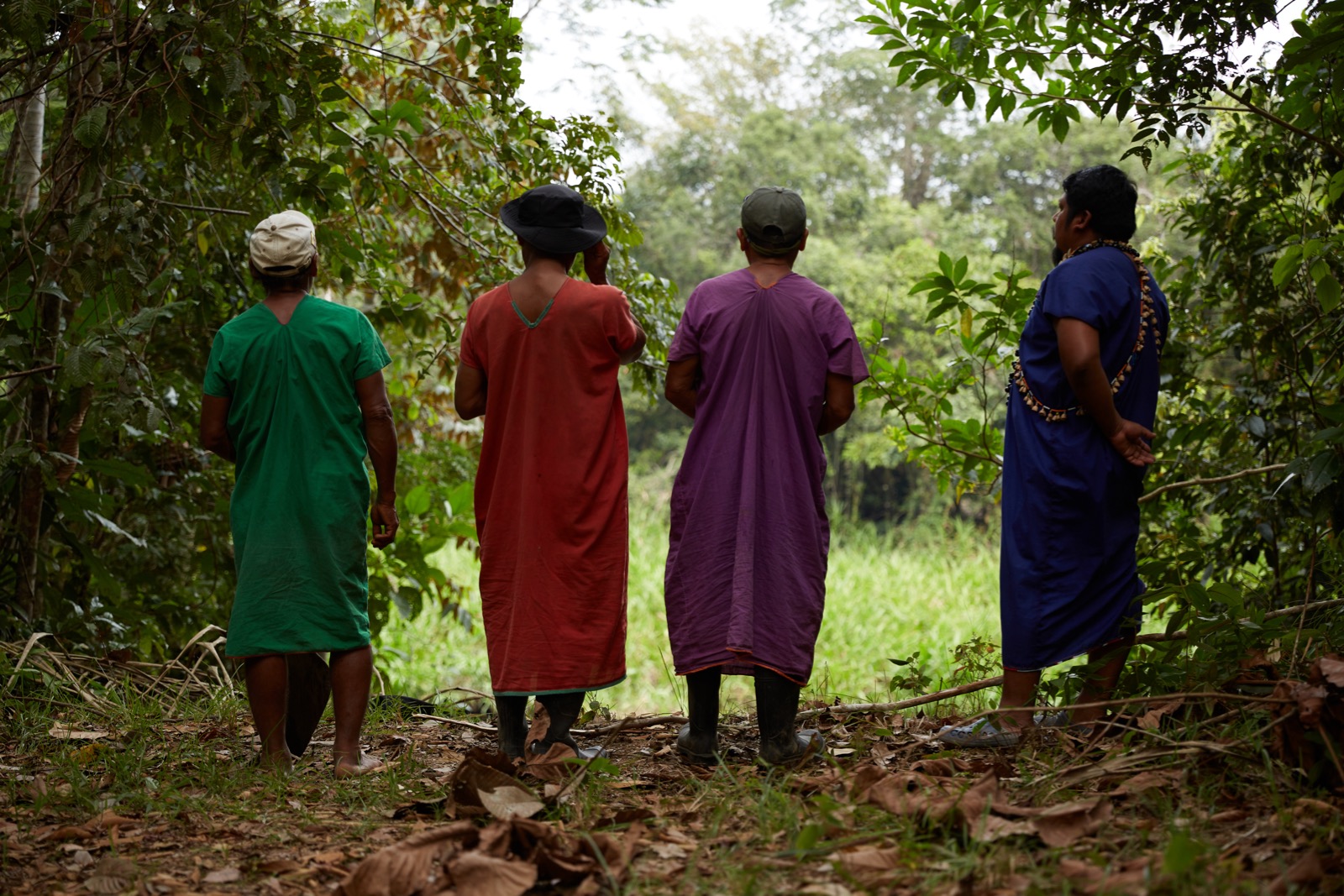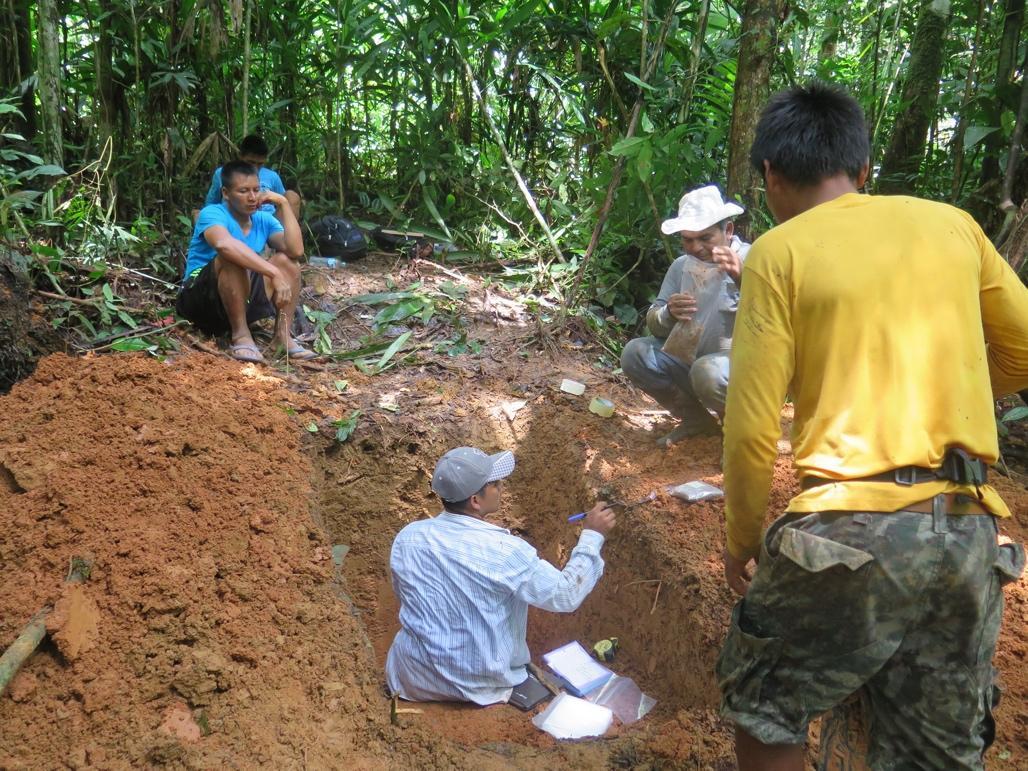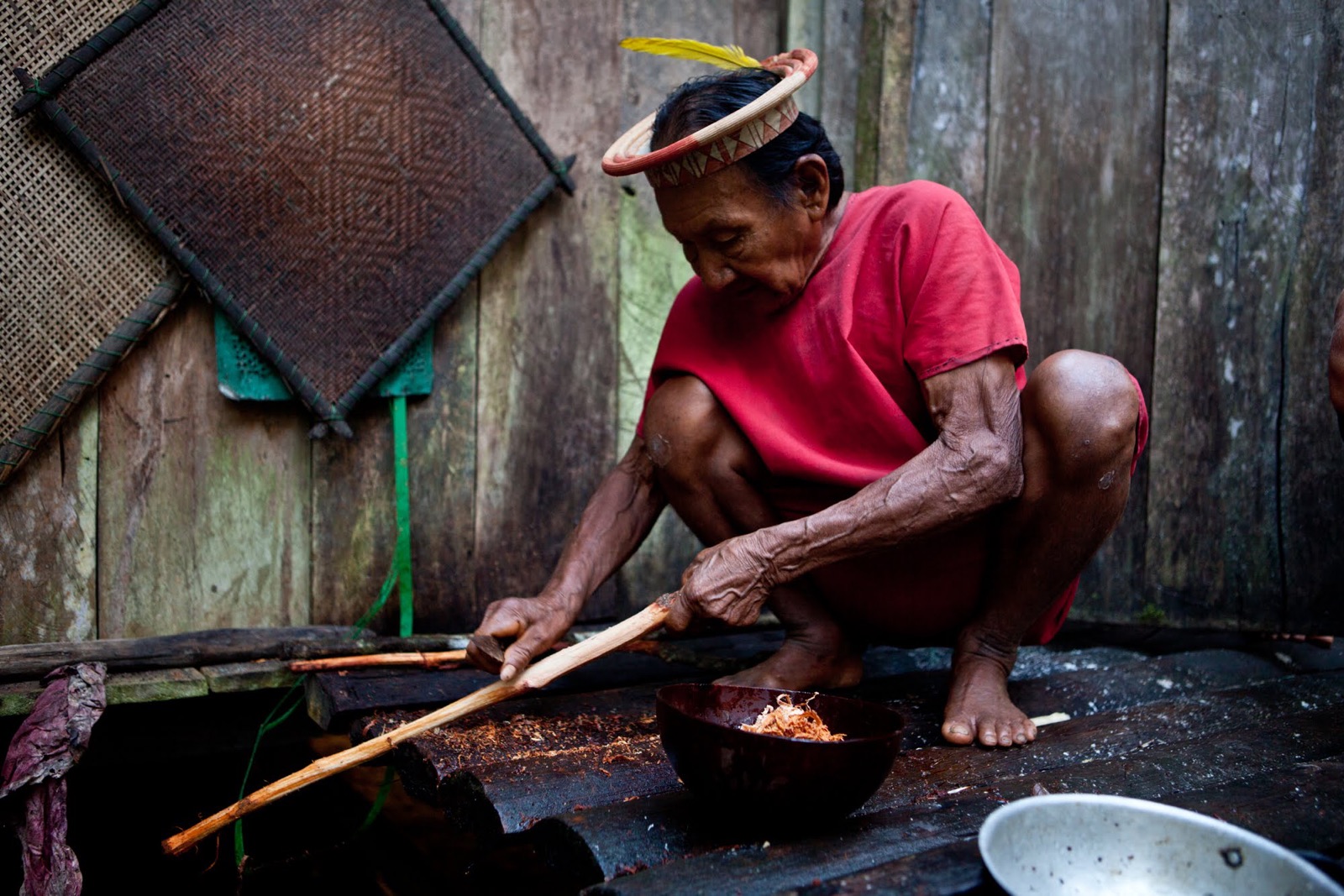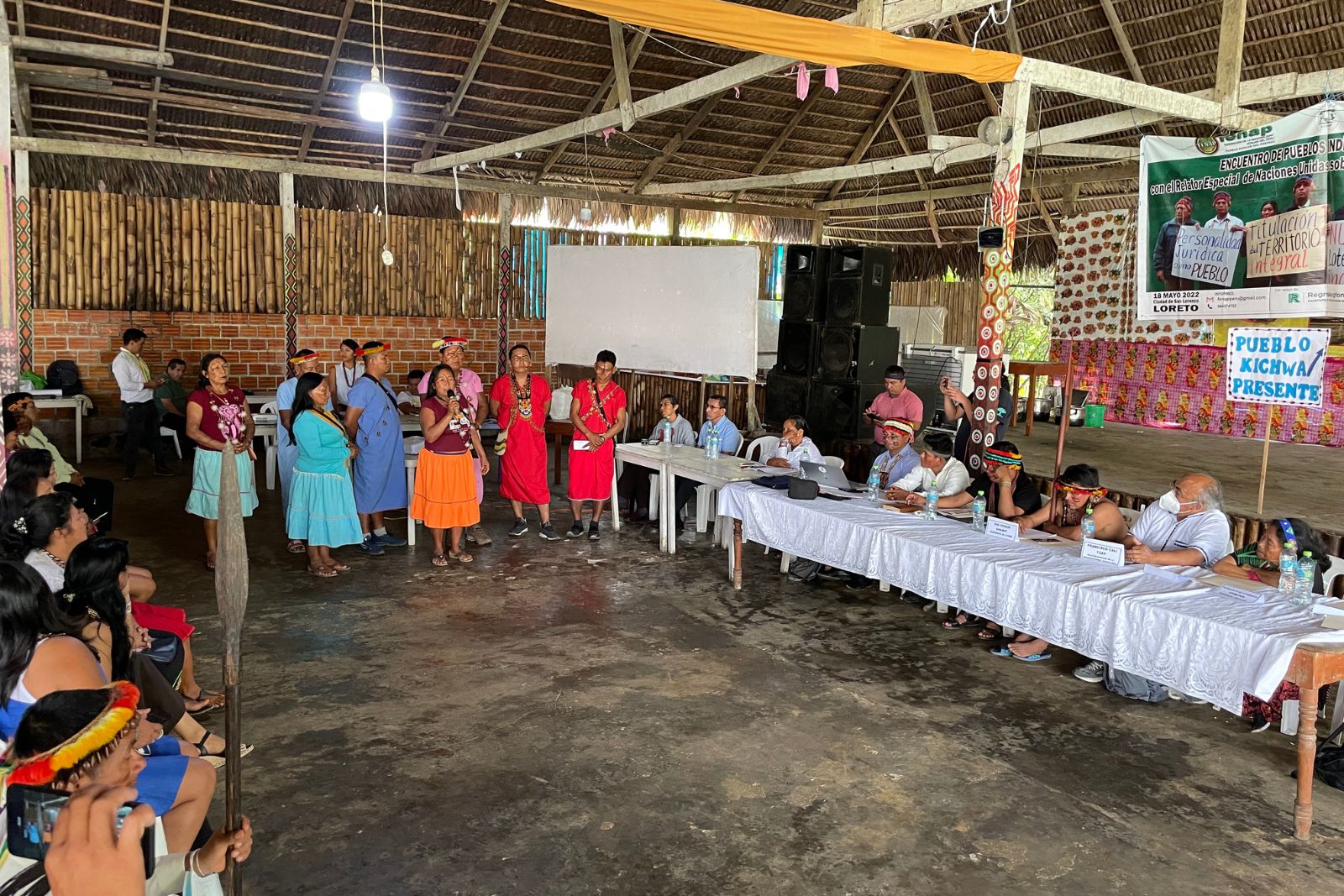Imagine this scene. You are on the territory your ancestors have lived on and protected for hundreds of generations, thousands of years. Suddenly, a person from a city far away, who has never been to your territory, arrives to tell you what you can use this territory for, and that this isn’t really your land after all.
This is not a hypothetical scenario, but a story.

The month is April. The humid morning air hums with the song of insects. Three teenagers from the Indigenous Siekopai nation (also known as Secoya, particularly in Peru) stare down into the rectangular hole they have just finished digging from the compact, red-clay soils so common in this part of the Amazon in northern Peru. Sitting in the hole, a young engineer who has arrived from the Peruvian capital city of Lima crouches down, whispering to himself, as he examines the seemingly ordinary dirt.
The engineer has been led to this specific spot by a GPS unit, which auto-generated a random location for soil sampling.
The teenagers smile amid the unspoken absurdity of expending so much energy, digging holes in an apparently insignificant spot deep in the jungle, without any conceivable reason, with no armadillo or paca (prized hunted animals) to justify the effort. Wiping sweat from his brow, a youth remarks, “Well, the hole would make a fine pitfall for an animal … let’s be sure to hang some bush meat over it to attract a tortoise once this city kid leaves.”
Another, Fidel, is impressed at the young engineer’s proficiency in forming perfectly round spheres of mud between his thumb and index finger: “We should take this [city] kid fishing, he can roll the fish bait balls for us.” “I’m taking him on an armadillo hunt” , declares the eldest of the three, “he’s darn good with that shovel, even if he does need gloves.”
Meanwhile, the other women and children who tagged along for the general excitement of the day are diligently collecting the bounties of the surrounding forest as casually as a Sunday stroll through a market: sweet tree-fruits rich in vitamins and flavor, chambira palm fiber for twining cordage, stripped tree barks for medicines and pack strappings, a yoco vine yanked down from the canopy to be drank as a morning stimulant instead of coffee, and many other oddly shaped branches and reeds are piled up to be later crafted into culinary utensils.

Much less apparent to the group of Siekopai accompanying the day is the reason for the absurdity, the rationale for why this person from a faraway place is sitting in a hole in the middle of the jungle, with his trowel kit, soil charts, and zip-lock bags. The young engineer, freshly groomed as a soil scientist from one of Peru’s finest universities, is in effect determining whether or not this particular tract of forest – wherein the Siekopai people have co-existed since before the arrival of Spanish colonizers – will be titled as Siekopai property, or to the perverse contrary, as State Land on loan to the community under a condition called ‘assignment in use’ (cesión en uso).
At the core of the issue are two starkly contrasting relationships with the living world, and two opposing visions of what land is for. On the one hand is the dominant understanding, implemented by the Peruvian government, which is rooted in the assumption that land is exclusively for production. The state’s land titling entity is housed within the Ministry of Agriculture, and is guided by indisputable agrarian principles and laws forged over decades of mass colonization of unrecognized Indigenous lands.
On the other hand are Indigenous peoples who have maintained a much more integral and intimate relationship with their land, one of generative coexistence that has evolved and refined with the accumulation of knowledge and experience over millennia. Jorge Perez, the current President of AIDESEP (The Interethnic Association for the Development of the Peruvian Forest) reflects that “most Indigenous peoples describe their ancestral territory as a very part of their existence. Wherein one depends on the other. The territory is the main source of material and spiritual life. The effective transfer of knowledge from generation to generation is only possible through the resources of the territory.”
The State’s Understanding of Soil
A decisive step in the cumbersome administrative procedure that recognizes Indigenous property rights in Peru is a soil analysis and classification which determines its “most adequate use”. The analysis interprets the physical and chemical properties of the subsurface soil layers along with topographical characteristics, and culminates in a report of the compatibility of the soils for one of four possible activities: the permanent cultivation of crops, livestock grazing, forest production, or protection. The segments within the area that are deemed apt for cultivation and grazing receive a property title, and the areas that are designated as forest lands and protection (which constitute over 70% of the Peruvian Amazon) are conceded to the community as a loose concession (‘cesión en uso’) which can explicitly be revoked. In essence, if the land does not use intensive methods of agriculture or grazing, fitting to a colonial standard of territorial use, in fine print, it does not have secure property status.
This assessment clearly disregards, devalues and disrespects Indigenous relations to territory, which allowed for sustained survival through agriculture, hunting, fishing, foraging, and nourishing the forest. As Rodrigo Papaya from the Mashunta community explains, “for us, the Secoya (Siekopai), the [idea of] land being suitable for agriculture or forestry doesn’t exist, the ‘cesión en uso’ (assignment in use) doesn’t exist, because we use everything, because [in the forest is] our pharmacy and our market, our pure air.”
For example, perhaps the most common technique of agriculture and forest management among Amazonian Indigenous peoples is swidden-fallow cultivation. This shifting system can be described as a continuum of cultivated plants and fruit-bearing trees and natural vegetation over a period of several decades that ensures soil recuperation, and the re-establishment of diverse and even enriched forests after abandonment. In contrast to practices of extractive colonial monoculture, this traditional cultivation system employs a diversity of crops and trees; a study of Mora peoples in Peru documented over 60 planted species. Notably, this system uses a much more diverse spectrum of soils and forest types than what is currently recognized by the Ministry of Agriculture as “suitable for permanent cultivation”; the diversity of plants and trees used by Indigenous people is far broader than the agricultural practices understood by the colonial mindset.

Siekopai elder Delfin rasping a yoko vine , the highly caffeinated liana (woody vine) drank before dawn as a stimulant.
Indigenous peoples depend and thrive upon a diversity of forest types and ecosystems for everything from the collection of medicines, fruits, fibers for ropes and fabrics, materials for constructing their homes, hunting and fishing, as well as intangibles such as spirituality, the history of past settlements and wars, and endless other place-based memories. In terms of plant use alone, a single Siekopai elder, Delfin Payaguaje, identified the names and uses of more than one thousand plants over a broad range of ecosystems, and did so over the course of only several days.
The incompatibility of Peruvian law with the reality of Indigenous life is further displayed by the law’s understanding of what lands are deemed apt for livestock. Peruvian law contemplates grazing territories as lands entirely cleared to make way for intensive livestock grazing, rather than small-scale livestock populations living in a community. Nearly all contacted Indigenous communities can be found with chickens and ducks roaming about, but to assume that they have assimilated the colonist cowboy culture of ranches and plantations is absurd.
Oscar Macanilla, a long-time leader of the Indigenous Siekopai people from the village of Wajoya (River of War) in the upper Loreto region of Peru, recounts his village’s first and last attempt at adopting cattle into their livelihoods.
“It was the local mayor’s idea… he gave us ten water buffalo so we could learn to become happy ranchers… we felled much of our forest, and in its place planted grass. In the beginning things were odd but under control… but soon the buffalo got big, they began to disrupt the harmony of village life, chase the children around, thrash our plantain trees and manioc plants with their horn, and their steaming hot dung piles all over the yard were unbearable … eventually things got so out of hand and dangerous that we abandoned the village and moved here to escape the savage beasts.”
Peruvian law denies the title of ownership to communities on their ancestral territories, based on a regulation that does not take into account or respect their historical ways of life and relationship with their lands. The regulation exclusively relies on narrow agricultural or productive criteria, denying the existence of different cultures and worldviews in Peru. The Peruvian government, exercising this legal framework, continues to sign temporary concessionary contracts which undermine ancestral ownership and place Indigenous peoples at risk of losing territory. Not only do these contracts undermine the rights and traditional relations of Indigenous communities, they also contradict International agreements, most notably Article 14 of the 169 ILO Convention that guarantees that indigenous territories be recognized as property.
Currently, less than two-fifths of Siekopai territory in Peru is recognised as property of Siekopai communities; the rest is merely ceded as an ‘assignment in use’. The communities are demanding a full recognition of the territory as property.
It is for this reason that on December 16 2021, three Siekopai communities from the upper Loreto Province, represented by Juan Carlos Ruiz from the Institute for Legal Defence – Lima (IDL) and supported by Amazon Frontlines and the Ceibo Alliance, presented a constitutional claim at the Putumayo Provincial courthouse in Estrecho, requesting the judge uphold their collective rights to property, and reject the application of Article 11 of the Peruvian law 22175 that allows for the state to grant native communities their ancestral territories under the “cesion en uso” framework.
In Peruvian law, the protections granted by international treaties such as the ILO’s Indigenous and Tribal Peoples Convention have a constitutional status; this means they are above national laws. The demand of the Siekoya-led legal process is for the district judge to recognise the violation of constitutional rights, ordering the government to modify the current titles, so as to recognize the ownership of the entire territory traditionally and ancestrally occupied by the Siekopai communities. But the state has been doing its utmost to delay and obstruct this legal demand; a recent hearing scheduled for January 2023 to discuss the Siekopai claim was postponed to April 2023.

Siekopai community members present their demands in Loreto, Peru.
The Siekopai communities of Loreto face an arduous process as their claim makes its way through the layers of Peru’s legal system. But the possibilities of obtaining greater juridical security over their ancestral territory are clear, as is the opportunity for the rights of communities across Peru to be upheld. As Amazon Frontlines’ Rights Coordinator Jorge Acero notes, “This process must have a favorable sentence for the Siekopai and their rights, being a regional and national precedent that other communities can use and that presses for the essential reform of the laws that seriously violate the rights of the Peruvian communities and peoples to their ancestral territories.”
Indigenous communities have a non-negotiable right to their ancestral territories. As Hilda Leví, a Siekopai grandmother, declared to the United Nations Rapporteur on Indigenous Peoples during a recent visit to San Lorenzo-Loreto Peru: “The forest is our home, it provides everything we need to survive and be happy…it’s our pharmacy of plants, our supermarket, our hardware store, our temple… and in turn, we take care of and protect our forest… we know what to plant and where to plant it, where and when to hunt and fish and where and when not to…where to build our villages and where not to … and sir, let it be heard that we know what to do with our dirt, that’s our decision, and always will be.”

Siekopai leaders testify before Francisco Cali Tzay, UN Human Rights Council Special Rapporteur on the Rights of Indigenous Peoples from 2021.
Whether by testifying to UN rapporteurs, or requesting their rights be respected before district judges, Siekopai communities are demanding legal recognition for a millenary relationship of co-thriving with land, that long-precedes the existence of the Peruvian state.
Key sub-points
- Peru’s discriminatory legal system only recognizes property rights on territories that comply with a colonial understanding of agriculture and grazing. Land can only be property if it fulfills a capitalist logic of extraction.
- The law neglects and devalues Indigenous history, culture, practices and worldviews, on their lands, depriving communities of protected property rights, and leaving them at risk of losing access to their territory.
- Siekopai communities are taking the Peruvian government to court, demanding the state recognise their ancestral territories in line with international law. They have the potential to achieve a game-changing precedent in how the Peruvian government understands land and property rights in relation to Indigenous peoples.
More than 50% of the world’s land is held by Indigenous peoples and local communities, yet only 10% is legally recognized, leaving them and their forests increasingly vulnerable to incursion and deforestation. Support our work to secure land titles for Indigenous communities protecting the Amazon rainforest and our climate:




